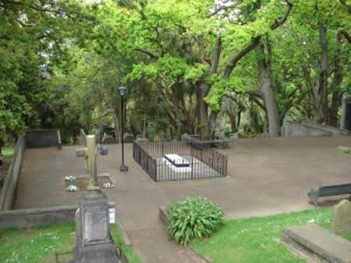SIGNIFICANT GRAVES
GOVERNOR HOBSON’S GRAVE
Hobson granted eight acres to the Anglican Church for use as a Cemetery in 1842. Ironically he was one of the first people to be buried in the Anglican Cemetery, as soon after he suffered a fatal stroke.
He is certainly the most important personage buried there and the only Governor or Governor-General to be buried in New Zealand until Sir Keith Holyoake who died in 1983.
His coffin lies in a brick vault beneath the tombstone and platform. The three types of stone used on Hobson’s grave were intended to be symbolic; the lowest slab is Tasmanian Sandstone which evokes Hobson’s career in Tasmania before 1840. This was later augmented by a panel of Italian white statuary marble for the inscription. Finally, a piece of black Irish marble was inserted between them that alludes to Hobson’s birthplace in Waterford, Ireland.
William Hobson joined the Royal Navy in 1803 and was promoted to the rank of Commander in 1824. In 1834 he was given the command of the ship HMS Rattlesnake and ordered to take it to New South Wales where, in 1836, he attended the Governor, Sir George Gipps.
In 1837 Gipps received a request for help from James Busby, a British resident in the Bay of Islands, New Zealand, where a number of Europeans, mostly Britons, were living. New Zealand was nominally, but not formally, part of the Colony of New South Wales at this time.
Gipps sent Hobson to investigate the situation. Hobson submitted a report to the British Government advising that New Zealand be annexed as a colony. This resulted in Hobson’s eventual appointment to Governor of New Zealand and the founding of the City of Auckland as the colony’s new capital in 1840.
Hobson’s grave is now the centerpiece of the General Anglican Memorial which was created in the 1960s when the new motorway system was constructed. The New Zealand Royal Navy looks after Hobson’s Grave and a commemorative service was held at the grave each year.
The lamp next to his grave is a symbolic gesture for the founder of Auckland and New Zealand; it is the only lamp inside the Symonds Street Cemetery. The pavement around his grave is the top of a burial vault in which the remains of around 2000 Anglicans were re-interred. Some of their names are listed on the memorial wall to the south of the paved area next to a white marble plaque from the 1910 Cemetery Archway. A separate memorial vault was created on the western side of the cemetery in the Catholic area which contains the remains of just over 1000 Catholics. The names of some of the deceased are laid out on bronze plaques on top of the vault.
TE IRINGA O RAURU
There is speculation that the area set aside by Governor Hobson for the cemetery may have been a pre-European burial ground. Certainly, it was connected with death in one specific way. The area where the Symonds Street ridge meets the Karangahape ridge was known as Te Iringa o Rauru - “the hanging up of Rauru’s body”. Rauru was a Ngati Whatua chief slain by the Waiohua. As a warning to others his body was hung up on a tree, which thus became tapu. This act was a contributing factor in the attack by Ngati Whatua on the Waiohua and Ngati Paoa tribes around 1740 and their subsequent occupation of Tamaki Makaurau. Standing as it did on the top of a hill and next to a major walking route, the tree would have acquired a terrible and sinister reputation, evidence of a horrible and dishonourable crime. This tree apparently wasn’t extant when the first Europeans arrived. The area was noted for being a rather bleak hillside and there is no reference to a tree or image of one in the vicinity.


